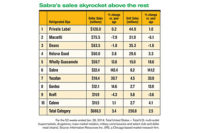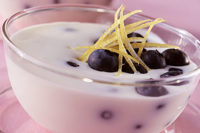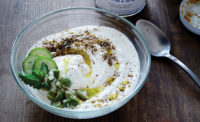When you listen to the buzz in the cultured dairy aisle, it’s hard not to hear a lot about Greek yogurt, as its popularity continues to drive growth for the category. But the story goes beyond just Greek yogurt; it’s about what this spotlight is doing for the category as a whole. Yogurt is hot and consumers’ interest doesn’t show any signs of waning soon. Whether the talk is about high-protein, exotic flavors, healthy alternatives for dessert, convenient snacking or being used as an ingredient — yogurt is answering the call.
But the story in yogurt isn’t just about the explosion in fruits and flavors. Processors are innovating with packaging as well, using single cups, cups with sidecars, squeezable pouches and multipacks (often created on form-fill-seal equipment).
Read the entire Industry Outlook
Total U.S. retail sales of yogurt are estimated to reach $7.4 billion in 2013, which is a 6.4% increase over 2011 and the fifth consecutive year of growth, according Chicago-based Mintel. Yogurt sales have increased by an impressive 40% since 2008 and future growth could remain strong as consumers continue to demand healthier snack alternatives and remain attracted to new varieties and brands of Greek yogurt products, Mintel’s report indicates. In addition, yogurt’s health benefits are a key purchase driver for the market, with yogurt ideally being positioned as a healthy alternative to snacks, desserts and other breakfast choices.
No surprise, the major driver of yogurt sales for 2013 continues to be Greek yogurt, with Norwich, N.Y.-based Chobani still leading the pack. The company experienced a sales increase of 21.3% to more than $1 billion, according to Mintel. In July, Chobani introduced 14 new flavors and formats to its Greek yogurt line-up. Among the new products are single-serve options, in flavors like coconut and orange vanilla. The company introduced Chobani Bite, a 3.5-ounce format, earlier this year, and recently added two more flavors — Mint with Dark Chocolate Chips and Honey Ginger. New flavors were also added to its Flip line, including Peachy Pistachio and Tropical Escape.
Also notable was the entrance of White Plains, N.Y.-based Dannon’s Oikos brand in a significant way into the market. Oikos sales increased 164.7% during the 52 weeks ended May 19, 2013, according to Mintel. New products this year for Dannon included Activia Greek and Light & Fit Greek, which contain 80 calories per 5.3-ounce serving.
But many other brands are vying for attention in the Greek yogurt arena. New Greek yogurt lines hit the market this year from Springfield, Mo.-based Hiland Dairy, Carlinville, Ill.-based Prairie Farmsand Norman’s, Rutherford, N.J., with the first Cholov Yisroel Kosher Greek yogurt. General Mills’ Yoplait, Minneapolis, introduced a new blended Yoplait Greek yogurt to its line, available in six flavors, including coconut and tangerine.
“We’re seeing Greek [yogurt] pop up in all the category’s sub-segments — such as light yogurt, frozen yogurt and yogurt oriented toward particular health benefits like digestive health — as well as availability in new textures such as blended (i.e. with fruit/flavor mixed in) versus the traditional fruit-on-the-bottom,” said Amy Elkes, brand program and consumer insights manager for Stonyfield, Londonderry, N.H. “So, Greek [yogurt] is making its way into every part of the yogurt aisle.”
Berry flavors are still popular in yogurts, according to the Dairy Foods2013 Ingredients Study. Yogurt processors said the top five flavors they plan on using are: banana, mango, blueberry, raspberry and strawberry. But processors are starting to look beyond the traditional strawberry and blueberry and are dipping into interesting flavor combinations or exotic fruits.
The flavor game
With the competition among yogurt processors getting fierce, the flavor game has started. Consumers are looking for healthy indulgence and unique flavors that stand out, and many are answering the call.
“Indulgence is showing up in the form of fun toppings and more exotic and dessert-like flavors,” said Elkes. Stonyfield launched its new line of custard-style yogurt called Blends last spring. Flavors include peach mango, blackberry, lemon and strawberry banana.
Sun Valley Dairy, Sun Valley, Calif., producers of Voskos Greek Yogurt, recently expanded its distribution in the Northeast United States in hopes of gaining more traction. Its unique flavor combinations, like honey crunch, honey vanilla bean, exotic fig and apricot mango, are helping the company to stand out. Another processor hoping to gain attention with its bold flavors is Dreaming Cow, Pavo, Ga. The New Zealand-style artisan yogurt company launched two new flavors, Blueberry Cardamom and Dark Cherry Chai in its 6-ounce packages. This farmstead yogurt features a cream top.
Mountlake Terrace, Wash.-based The Greek Gods, a brand from The Hain Celestial Group Inc., added a new Honey Salted Caramel flavor to its line. Yoplait also released two new single-serve flavors in its Greek 100 line, lemon and tropical. Flavors that lean toward the tropical focus are showing up more often throughout the yogurt industry, not just in Greek.
Greek yogurt company Fage, Johnstown, N.Y., launched three new unique flavors in its Total 0% line, including Apple Cinnamon Raisins and Orange Cinnamon. The inspiration behind these new flavors comes from consumer demand and appealing to its “foodie” audience, according to Russell Evans, marketing director. The company also released a brand new line FruYo, which contains pieces of real fruit folded into the Total yogurt. It’s available in seven flavors, including pineapple, peach and raspberry. This is the first blended yogurt for the company, which started a national TV campaign this fall featuring Chef Bobby Flay in the commercials.
Tillamook County Creamery, Tillamook, Ore., took the flavor game to a whole new level by introducing its new dessert yogurt line, a first-of-its-kind product. It comes in three dessert-friendly flavors, Honey Cinnamon Crème Brûlée, Marionberry Cobbler and Peach Raspberry á la Mode. The dessert yogurt is available in 24-ounce family-sized containers.
Greek yogurt for men
Though Mintel reports that women are still more likely than men to eat spoonable yogurts in both Greek and non-Greek forms, some companies are trying to change that narrative by emphasizing the high-protein benefits.
Powerful Yogurt, Miami Beach, Fla., claims it launched the first Greek yogurt in the United States designed specifically for men. The product is differentiated from existing Greek yogurts by its 20 to 25 grams of natural protein per serving. It’s sold in a “man-sized” 8-ounce cup that is 33% larger than most individual-serving Greek yogurts. The marketing and black-and-red packaging are designed to target active male consumers. With the emphasis on high protein, Powerful Yogurt is supposed to help men build muscle, burn fat and improve digestive health, according to the company. Another brand, Mammoth Yogurt, made by Fonterra Brands in New Zealand, is also marketed to men. The thick yogurt is made with grains or seeds and fruit, and is packed in a 325-gram (approximately 11.5-ounces) pot — described as a man-sized tub — and contains a spoon. It was named best fresh dairy product in the Sial D’Or awards at the 2012 Sial tradeshow in Paris.
Michael Neuwirth, senior director of public relations for Dannon, said the company is now promoting Greek yogurt to men as well based on it being an excellent protein source. Recent ad campaigns talk about “The New Protein, Dannon Oikos nonfat yogurt” and show the yogurt atop a grill or in between two buns, directly trying to appeal to a male audience.
Move over Greek yogurt
Though Greek yogurt continues to drive the yogurt category and dominate the news, another trend has been showing up — other international-style yogurts are popping up and ready to compete. The United Nations of Yogurt includes Australian, Bulgarian, Icelandic and European styles.
Take Noosa Finest Yoghurt’s Aussie-style yogurt which features exotic flavors like Passion Fruit, Strawberry Rhubarb and Tart Cherry; or MüllerQuaker Dairy’s European-style Müller Corner and Müller FrütUp (with its unique flavors and fruit mousse on the top). Then there’s Smari’s Icelandic yogurt, which has a whopping 17 to 20 grams of protein per 6-ounce serving.
“We’re definitely seeing a huge rise in international-style yogurts hitting the shelves,” said Koel Thomae, co-founder of Noosa Finest Yoghurt. “As more and more people have embraced yogurt as a part of their diets, they’re looking for variety and something new.” Noosa plans to introduce a plain version of its yogurt soon. The company also launched a variety pack, which features 12 smaller-sized, 4-ounce servings in a mix of three flavors, including its new lemon flavor.
Another new yogurt on the market is Trimona’s organic Bulgarian yogurt. The yogurt is made with grass-fed milk and contains no added sugar, with approximately 6 grams of sugar per cup. Trimona is currently only available in plain, but the Port Jefferson, N.Y.-based company is expected to release flavors in 6-ounce cups by the end of this year or early 2014.
Yogurt, not just for spooning
The rise in yogurt products on the market has given way to a whole new trend — on-the-go yogurts. As many processors look to increase the usage occasions beyond breakfast, that means convenient snacking options.
New York-based Happy Family introduced its Happy Squeeze Greek yogurt, a line of on-the-go pouches designed for easy snacking for people of all ages. The company also released new Greek yogurt pouches for babies and toddlers earlier in the year. The Greek Gods brand went portable by adding a drinkable low-fat Greek kefir to its line. Lifeway Foods Inc., Morton Grove, Ill., known for its drinkable kefirs, added a new honey fig flavor to its line. The company also reformulated its Helios organic drinkable kefir, taking the protein from 12 grams to 16 grams and adding a new flavor, pear and honey.
According to Mintel, yogurt drink sales have experienced a recent increase with products aimed at parents and children being a major driver of growth for the segment. Focusing on the trend of new baby, toddler and children yogurt products presents a great opportunity for yogurt processors.
“The biggest opportunities are development in baby and kids yogurt and clearly defining the importance of organics versus conventional in yogurt,” said Matt Newsom, vice president of sales for Stonyfield. “Retail customers are very focused on capturing the new mom shopper segment due to the spending and loyalty this shopper brings to the business.”
Following the grab-and-go trend and marketing to children/moms, Stonyfield launched YoKids Smoothies, made with real organic fruit and vegetable purees in two flavors. Lifeway Foods also introduced ProBugs Bites, freeze-dried kefir melts for babies. The shelf-stable bites (sold in pouches) dissolve quickly in a baby’s mouth for safe and easy self-feeding. Organic baby food maker Sprout Baby, Atlanta, created three Superfruit & Greek yogurt-based items for toddlers. The company also added four Fruity Yogurt Bite snacks for toddlers. The snack bites consist of freeze-dried organic yogurt and fruit pieces in one packet. Sprout also added the new line Smash Smoothies, aimed at elementary school-aged children. The smoothies feature combinations of fruits, veggies, coconut milk, quinoa and Greek yogurt, and are also sold in easy-to-drink pouches.
Yoplait recently reformulated its kid-friendly Go-Gurt brand. The yogurt has new vibrant packaging featuring a new health message: no high-fructose corn syrup. The yogurt’s new formula contains 1 gram less of sugar, and 10 fewer calories (60 calories per serving). It is made with natural flavors and colors.
Müller Quaker Dairy also sweetens without high fructose corn syrup and uses no artificial flavors. It will use only colors from natural sources when it starts producing the entire yogurt in Batavia, N.Y., said Director of Communications, Scott Gilmore, Chicago. Some yogurt is being shipped from Europe.
Coach Farms, Pine Plains, N.Y., added a new blackberry flavor this month to its Yo-Goat drinkable goat’s milk yogurt line. The cultured Grade A goat’s milk is sold in 8-ounce bottles and available in four other flavors including strawberry and mango peach.
Dipping into flavor/talking protein
The flavor game goes beyond the yogurt aisle as processors of dips and sour creams are grabbing attention with indulgent and bold flavor combinations and using Greek yogurt as ingredient.
Heluva Good!, a brand of HP Hood LLC, Lynnfield, Mass., launched four new Greek-style yogurt dips, including Herb Ranch, Southwestern Chipotle and Fire Roasted Vegetables (see aticle here). La Terra Fina, Union City, Calif., created a line of refrigerated dairy dips made with Greek yogurt. Its unique flavors include Yellow Pepper and Lentil, Caramelized Onion and Red Lentil Curry. Phoenix-based Shamrock Farms introduced a new line of farm-fresh flavored sour creams with three interesting flavors, including Zesty Jalapeno. Dannon added Oikos Greek Yogurt Dips to its line as an alternative to traditional dairy dips, with less fat and 25 calories per serving. Flavors include French Onion, Roasted Red Pepper and Cucumber Dill.
Kraft Foods’ Philadelphia Cream Cheese focused on bold with its latest cream cheese flavors — Chipotle and Brown Sugar and Cinnamon. Earlier in the year the company released a Spicy Jalapeño flavor.
Smith Dairy Products Co., Orrville, Ohio, added a new all-natural French onion dip to its product line. Anderson Erickson, Des Moines, Iowa, added a Bacon French Onion sour cream flavor to its line. Attempting to shake up its cottage cheese lines, Breakstone’sand Knudsen (brands of Kraft Foods) added Mango and Raspberry Cottage Double flavors earlier this year. This fall the company added Greek-style Sour Cream & Nonfat Yogurt to the Breakstone’s/Knudsen line. The sour cream features 50% less fat and two times the protein (2 grams per serving).
Some makers of cream cheese and sour cream are getting on board with the high-protein message, but many more cultured processors (especially cottage cheese) need to get with the program. A half-cup of cottage cheese typically contains 11 grams of protein.
“We think cottage cheese is ready for a revival; especially since the product has protein content as high, if not higher, than many Greek Yogurts,” said Pete Kondrup, general manager, Westby Cooperative Creamery, Westby, Wis. “The category needs some new dressing; pun intended.”
Martin T. Weaver, director of sales and marketing at Umpqua Dairy Products, Roseburg, Ore., said, “I think that with the introduction of higher-protein diets and additional protein being added to a number of products, we will see a shift in the consumers’ interest level for cottage cheese. It is a healthy and natural high-protein item.”
Umpqua’s Small Curd Cottage Cheese was awarded first place as the “Best of the Best” at the World Dairy Expo Championship Dairy Product Contest last August. The company also released an all-natural cottage cheese that’s “slowly gaining traction,” said Weaver.
Franklin Foods, Enosburg Falls, Vt., launched the industry’s first Greek yogurt spreadable cheese, emphasizing its high-protein content. Kraft’s Philadelphia Cream Cheese also launched a new 2X Protein cream cheese this fall. The cream cheese has 4 grams of protein per serving, and comes in regular and honey flavors.
Dairy processors are counting on the continuing popularity of yogurt. Commonwealth Dairy (owners of Green Mountain Creamery, Brattleboro, Vt.,) in partnership with Ehrmann in October opened a Greek yogurt plant in Casa Grande, Ariz. Earlier this year, Franklin Foods built a Greek cream cheese plant in the same city. This year Müller Quaker Dairy opened a 350,000-square-foot plant on 82 acres in Batavia, N.Y. It was designed for expansion capability. Byrne Dairy, Syracuse, N.Y., is building a 73,000-square-foot plant in Cortlandville, N.Y., where it will process conventional and Greek yogurt for private label and co-pack customers. (Search dairyplantsusa.com for a list of yogurt manufacturers in the United States.)
As yogurt dominates the dairy discussion, more cultured dairy processors would be smart to follow suit with the high protein emphasis, unique flavors and more snacking opportunities.
Producers of Cultured Products Are Talking About:
- Functional
- High-protein
- No-HFCS
- On-the-go
- Non-GMO
- Greek-style
- Indulgent flavors
- Grass-fed
- Low-sugar
Yogurt outside the box
The emphasis on more protein consumption and healthy eating has some processors highlighting the use of yogurt (especially Greek yogurt) as an ingredient in cooking.
Companies like Fage, Chobani and Dannon all feature sections on their websites with recipes showing how to incorporate Greek yogurt into cooking.
“Another great opportunity within the category stems from providing information on the benefits of cooking with Greek yogurt,” said Dannon’s Michael Neuwirth. “Most people have just started experimenting with cooking with Greek yogurt and are discovering its role as more than a snack or a breakfast item.”
Cristina Dennstedt, communications manager at Chobani said, “One of the biggest growth areas is the adoption of Greek Yogurt as an ingredient. [It] can be used to add moisture when baking or create a creamy texture in soup recipes.”
Fage, in addition to its TV campaign featuring Chef Bobby Flay, updated their website with a whole interactive recipe section. The site features Flay in recipe videos demonstrating how to cook with the yogurt. The makers of Trimona Bulgarian yogurt are specifically marketing its product to be used in cooking as an ingredient. The owner even does cooking demonstrations at Whole Foods stores.













